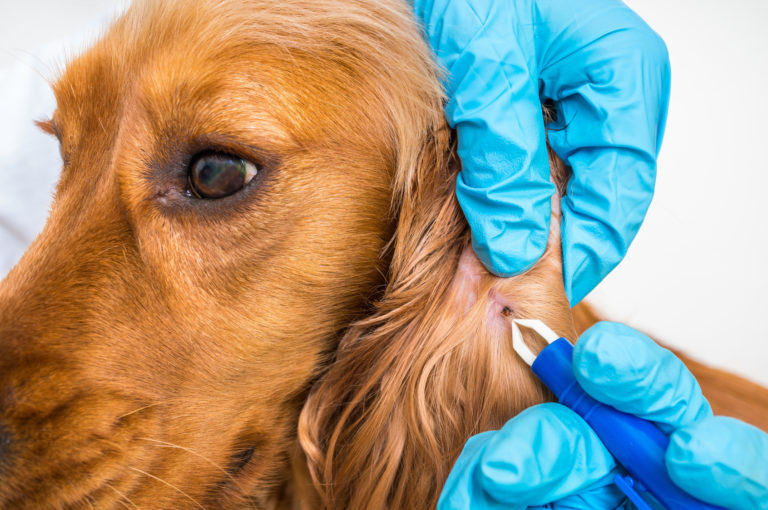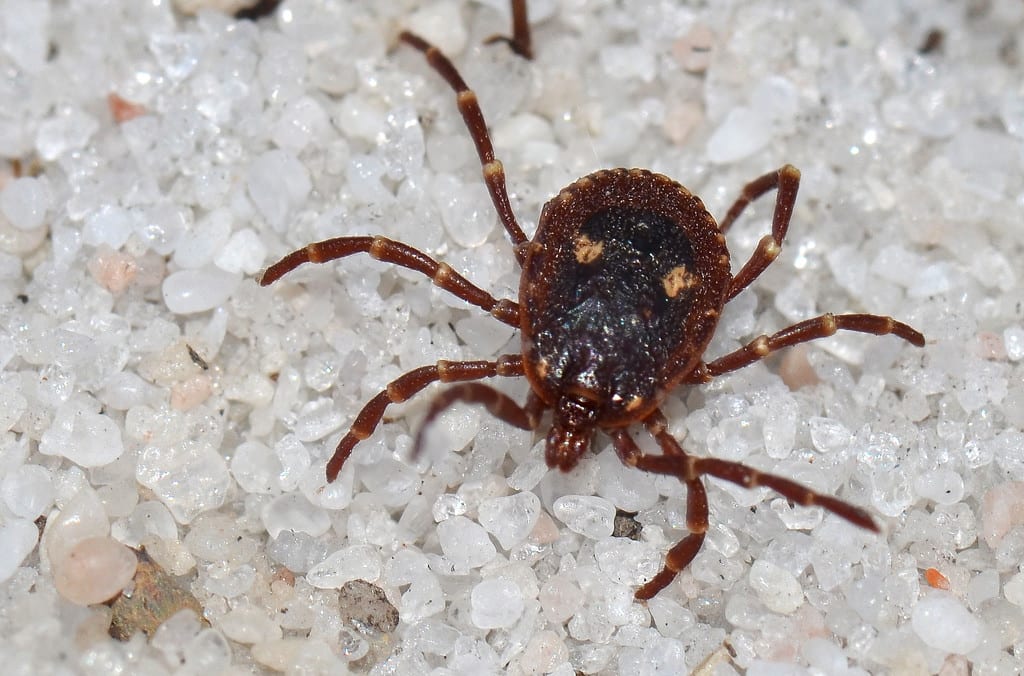Lyme disease in dogs symptoms
In this article, we will study Lyme disease. In order to better understand it, we will first look at the causes of this disease, then at its symptoms.
Finally, we will see that it is quite possible to protect your companion's health against Lyme disease by applying a few good gestures.
What is lyme disease?
Lyme disease is a disease that is caused by a bacterium called "Borrelia burgdorferi". Lyme disease may also be known as "borreliosis". This bacterium is inoculated by what is called a "hematophagous arthropod" such as a tick. In Greek, the word "hematophagous" means "feeding on blood" and the word "arthropod" means "jointed or segmented".
Not all ticks carry this bacterium, only ticks of the genus "ixodes ricinus" can transmit the disease. To transmit this bacterium, the tick will need to remain attached to its host, the dog, for at least 48 hours.
It is important to know that, like Leptospirosis, Lyme disease is a zoonosis. Zoonoses are common diseases and infections that can be transmitted naturally from vertebrates to humans and vice versa according to the World Health Organization. About thirty diseases can be transmitted by pets.
Lyme disease can be present on the whole French territory but the north and the east of France are more affected. The tick bites responsible for this disease generally occur between spring and autumn, a period favourable to parasites.
What is a tick?
In order to better understand this disease, it is important to know how to recognize a tick and its different characteristics. Ticks are what we call parasites, they need a host, in our case the dog, to feed and therefore to live.
They can measure between 1 and 5 mm in length when they are empty and can reach up to 30 mm after a good meal. They carry different bacteria that are responsible for different diseases.
Ticks love humid places such as undergrowth, forests and meadows. When walking in these places, it is important for you to wear long and tight clothes but also clear, this will allow you to spot more easily a tick on you.
If you spot a tick stuck in your skin, you must remove it as soon as possible. To do this, use a tick puller like you would for a dog. Insert the tick inside and turn it, it will come out by itself. Always remember to disinfect the site of the bite.

What are the symptoms of lyme disease?
It is important to know that the incubation period for the disease is very long because the first symptoms can appear several months after the tick bite. Boreliosis can present itself in two forms:
The acute form
The animal will present a hyperthermia which will lead to a decrease in appetite, pain in the joints due to an inflammation that can affect one or more joints which will lead to lameness. When stroking your pet, you will notice that its lymph nodes will be larger than usual, which is a sign of an infection.
The chronic form
In this form of the disease, the symptoms will be less pronounced. There will also be lameness but it will not be constant, it will appear at times. Heart and kidney failure may appear, as well as skin problems, especially around the tick bite.
How is this disease diagnosed?
It is not always easy for the veterinarian to diagnose this disease because of its long incubation time and the fact that the symptoms of this disease can be the symptoms of many other diseases.
To help him to make his diagnosis, the veterinarian will take into account the way of life of the animal: in which region it lives, if it is rather a country or city dog, if it is a hunting dog, then he will carry out a blood test which will allow him to carry out what we call "a serology". This last one will allow to put in evidence or not, the bacterium in the blood of the dog.
As with all diseases caused by bacteria, antibiotics are the mainstay of treatment. The veterinarian may also prescribe other medications, such as anti-inflammatory drugs, to relieve certain symptoms such as joint pain.

How can you prevent this disease?
Fortunately, it is possible to prevent your pet from getting this disease. Since the tick is the vector of this disease, it is important to prevent your pet from catching it. To do this, it is important to treat your pet regularly, especially from spring to fall, with external antiparasitics.
There are all kinds of products (pipettes, tablets, shampoo, collars), you must be extremely vigilant and diligent about the frequency of use of the product you buy.
In general, pipettes (such as Advantix or Frontline Combo) are used every month, while tablets and collars can be effective for longer periods. Ask your veterinarian for more information in order to optimize the effectiveness of the product.
In addition to the antiparasitic product, it is necessary after each walk in the forest to examine your dog thoroughly to ensure that there are no ticks. The antiparasitic products, even if they are very effective and essential, are not one hundred percent safe.
If you ever find a tick on your dog, it is important to remove it and make sure that the head is not left on your dog's body. To avoid this, take a tick hook or tweezers and turn as if you were unscrewing, you will see that the parasite comes off entirely.
Then, disinfect well with betadine the place of the bite.
Finally, in order to protect your pet as much as possible, there is a vaccine against this disease recommended especially for dogs living in regions at risk and for dogs with a lifestyle where they are exposed to ticks. This vaccine can be given as early as the third month of your pet's life.
The primary vaccination will be done in two injections about one month apart and then an annual booster will be necessary.
Last point of prevention to take into account: check that your house is not infested with ticks. If you have any doubts, we advise you to use an anti-parasite fumigant to eliminate any risk.

How can humans get this disease?
As for the dog, the human being will be contaminated by a bite of a tick of the type "ixodes ricinus". It is therefore important that you also protect yourself during your walks in the forest in areas at risk.
To protect yourself, it is best to wear long and tight clothing, especially on the legs, which are the most exposed to tall grass and therefore to ticks.
What are the symptoms in humans?
In humans, there are three phases of the disease:
First phase: in this first phase, we observe a skin problem called erythema chronicum migrans. It is mostly seen at the site of the tick bite. A central point is drawn then a red plate will surround it, it will have a rather oval shape. This skin lesion can appear up to one month after the bite. One can also feel a great fatigue, headaches, joint pains as in dogs. This lesion will disappear on its own in a few weeks.
Second phase: in general, it appears several months after the disappearance of the skin lesion. Then, cardiac problems (syncope, palpitations), neurological problems (meningitis) may appear.
Third phase: This one can appear years after the tick bite. Here again, skin, joint and neurological problems may appear. If you have been bitten by a tick, it is important to go to your doctor. Complementary examinations will be necessary at the consultation. Often an electrocardiogram, a complete neurological examination and a blood test will be requested.
The main treatment will be antibiotic therapy, sometimes hospitalization will be necessary. It should be noted that in humans, the disease is very well cured and it is very rare to observe the third phase of the disease.

If my dog has lyme disease, can it transmit it to me?
The answer is no, you cannot get the disease from contact with your dog. The tick must bite you for you to get the disease. The risk with your dog is that it brings a tick carrying the bacteria back to your home and then you get bitten in a second time, hence the importance of treating your dog and examining it after each walk.
In the case of lyme disease, prevention is key. The main thing is to protect your pet and its environment with antiparasitic products, increased vigilance after walks and a vaccination in case of a lifestyle exposed to this disease.
If your pet has this disease, there are treatments available. You should remember to tell your veterinarian all the symptoms you have noticed, as this will greatly help him in his diagnosis. And especially by protecting your pet, you protect him but also yourself because, we remind you, this disease is transmissible to humans.
Loving and educating your pet also means protecting it against the hazards of life. This is why we strongly recommend that you take out health insurance as soon as possible. This will save you astronomical veterinary fees in case of accident or illness.


